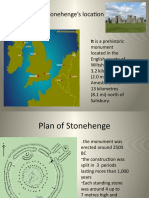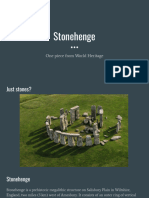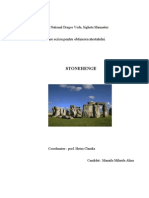0 ratings0% found this document useful (0 votes)
17 viewsIstoria Stonehenge
Istoria Stonehenge
Uploaded by
DARIA DORIANA COSTESCUStonehenge is a prehistoric stone circle located in Wiltshire, England that was built between 3000 and 1520 BC. It is considered one of the most sophisticated stone circles from the prehistoric period. While its true purpose is still unknown, it is believed Stonehenge was used for ceremonial purposes as early as 8000 BC and later served as a large cemetery between 3000-2300 BC. The monument was constructed using primitive tools and techniques to transport and erect the massive stones. The origin and builders of Stonehenge continue to be debated, though archaeological evidence points to early inhabitants of the British Isles.
Copyright:
© All Rights Reserved
Available Formats
Download as PDF, TXT or read online from Scribd
Istoria Stonehenge
Istoria Stonehenge
Uploaded by
DARIA DORIANA COSTESCU0 ratings0% found this document useful (0 votes)
17 views3 pagesStonehenge is a prehistoric stone circle located in Wiltshire, England that was built between 3000 and 1520 BC. It is considered one of the most sophisticated stone circles from the prehistoric period. While its true purpose is still unknown, it is believed Stonehenge was used for ceremonial purposes as early as 8000 BC and later served as a large cemetery between 3000-2300 BC. The monument was constructed using primitive tools and techniques to transport and erect the massive stones. The origin and builders of Stonehenge continue to be debated, though archaeological evidence points to early inhabitants of the British Isles.
Copyright
© © All Rights Reserved
Available Formats
PDF, TXT or read online from Scribd
Share this document
Did you find this document useful?
Is this content inappropriate?
Stonehenge is a prehistoric stone circle located in Wiltshire, England that was built between 3000 and 1520 BC. It is considered one of the most sophisticated stone circles from the prehistoric period. While its true purpose is still unknown, it is believed Stonehenge was used for ceremonial purposes as early as 8000 BC and later served as a large cemetery between 3000-2300 BC. The monument was constructed using primitive tools and techniques to transport and erect the massive stones. The origin and builders of Stonehenge continue to be debated, though archaeological evidence points to early inhabitants of the British Isles.
Copyright:
© All Rights Reserved
Available Formats
Download as PDF, TXT or read online from Scribd
Download as pdf or txt
0 ratings0% found this document useful (0 votes)
17 views3 pagesIstoria Stonehenge
Istoria Stonehenge
Uploaded by
DARIA DORIANA COSTESCUStonehenge is a prehistoric stone circle located in Wiltshire, England that was built between 3000 and 1520 BC. It is considered one of the most sophisticated stone circles from the prehistoric period. While its true purpose is still unknown, it is believed Stonehenge was used for ceremonial purposes as early as 8000 BC and later served as a large cemetery between 3000-2300 BC. The monument was constructed using primitive tools and techniques to transport and erect the massive stones. The origin and builders of Stonehenge continue to be debated, though archaeological evidence points to early inhabitants of the British Isles.
Copyright:
© All Rights Reserved
Available Formats
Download as PDF, TXT or read online from Scribd
Download as pdf or txt
You are on page 1of 3
History of Stonehenge
Learn interesting facts and listen to
captivating stories about one of the
world's most famous ancient
wonders.
Stonehenge is one of the most sophisticated prehistoric stone circles in the world and one
of the most famous monuments located on Salisbury Plain in Wiltshire, southern England.
The iconic Stonehenge was built in several stages between 3000 and 1520 BC.
The true purpose of Stonehenge is still unknown to us. There are assumptions that it was
a cemetery, a place of ceremonies or even an ancient calendar. There is evidence to
show that Stonehenge was used for ceremonial purposes between 8000 and 7000 BC.
Stonehenge hosted 150 and more cremation burials between 3000 and 2300 BC. and
became the largest cemetery in Britain.
Today, Stonehenge is a true masterpiece and a fantastic example of sophisticated ancient
architecture. It is a monument of engineering and construction by well-organized people
using only simple tools and technologies. A gem of English heritage, Stonehenge is a
spiritual place, a source of inspiration and a true wonder of the world.
To build the Stonehenge we know today, people used primitive prehistoric technology. To lift the stones, they had
to dig large pits with sloping sides. These holes are lined with a row of wooden stakes on which the stones were
then moved into position. The stones were held in a vertical position with the help of ropes made of vegetable
fibers. You can see the demonstration of how the stones were transported in an open gallery outside the
Stonehenge Visitor Center next to the reconstruction of the Neolithic houses.
There are many myths, stories and legends about Stonehenge. Various people have attributed the Stonehenge
monument to the Danes, Saxons, Romans, Greeks, Atlanteans, Egyptians, Phoenicians, Celts and even aliens.
But nevertheless, archaeological evidence shows us that early Mesolithic hunter-gatherers made the first changes
to Stonehenge.
DNA analysis of bodies buried near Stonehenge suggests that the Stonehenge builders came from outside
England, perhaps from the Mediterranean or Wales. Many also believed that Stonehenge was a Druid temple for
religious worship in the 17th and 18th centuries.
You might also like
- Stonehenge's Multiphase ConstructionDocument3 pagesStonehenge's Multiphase ConstructionTeodora RNo ratings yet
- Stonehenge Reading Comprehension and Past Modals of SpeculationDocument2 pagesStonehenge Reading Comprehension and Past Modals of Speculationapi-293205172No ratings yet
- The StonehengeDocument18 pagesThe StonehengeВера ЛегезаNo ratings yet
- StonehengeDocument1 pageStonehengeΜαρίνος ΡαϊνάκηςNo ratings yet
- Eric FloresDocument3 pagesEric FloresEric FloresNo ratings yet
- StonehengeDocument1 pageStonehengeOvidiu LucaNo ratings yet
- IELTS True False Not Given StonehengeDocument2 pagesIELTS True False Not Given StonehengeMajid KhanNo ratings yet
- StonehengeDocument2 pagesStonehengeCristina Maria MoldovanNo ratings yet
- Stonehenge FactsDocument4 pagesStonehenge FactsMei-Ann Cayabyab-PatanoNo ratings yet
- StonehengeDocument4 pagesStonehengeIuliana SoareNo ratings yet
- StonehengeDocument18 pagesStonehengeGigi GheorgheNo ratings yet
- The StonehengeDocument2 pagesThe StonehengeNadine El NasharNo ratings yet
- Stonehenge Leonardo Villamil English PresentationDocument2 pagesStonehenge Leonardo Villamil English Presentationl28villamilNo ratings yet
- Lm. UkDocument85 pagesLm. UkannakozhenkoNo ratings yet
- Unit 14Document1 pageUnit 14Elizabeth VegaNo ratings yet
- Stonehenge Presentation 1Document16 pagesStonehenge Presentation 1api-350579706No ratings yet
- Stonehenge - WikipediaDocument49 pagesStonehenge - Wikipedia13933138024No ratings yet
- LM-United KingdomDocument52 pagesLM-United KingdomLeugdlane SalongaNo ratings yet
- StonehengeDocument13 pagesStonehengeayaanmandelia2011100% (1)
- Stonehenge: Prehistoric Monument Wiltshire Standing Stones British Cultural Icon Archaeologists Burial GroundDocument2 pagesStonehenge: Prehistoric Monument Wiltshire Standing Stones British Cultural Icon Archaeologists Burial GroundNah Mendoza IriarteNo ratings yet
- Group 2 - Stonehenge - Britain's Prehistoric MonumentDocument7 pagesGroup 2 - Stonehenge - Britain's Prehistoric MonumentrealheartofficialsNo ratings yet
- Reading Passage 1Document4 pagesReading Passage 1md8sxjxb7zNo ratings yet
- Napi Angol Percek Augusztus 3Document5 pagesNapi Angol Percek Augusztus 3Zsuzsa SzékelyNo ratings yet
- All About Stonehenge: A Kid's Guide to England’s Mysterious Monument: Educational Books For Kids, #17From EverandAll About Stonehenge: A Kid's Guide to England’s Mysterious Monument: Educational Books For Kids, #17No ratings yet
- StonehengeDocument2 pagesStonehengeУльяна ЧеботарёваNo ratings yet
- StonehengeDocument19 pagesStonehengeavonpersu001No ratings yet
- StonehengeDocument2 pagesStonehengeirodjakNo ratings yet
- Not A Fortress, or A Temple, or A Calendar. Stonehenge Was A HospitalDocument5 pagesNot A Fortress, or A Temple, or A Calendar. Stonehenge Was A HospitalClaudia PerNo ratings yet
- 5 Strange Theories About The StonehengeDocument2 pages5 Strange Theories About The Stonehengelebene santiagoNo ratings yet
- Stonehenge: Facts & Theories About Mysterious MonumentDocument4 pagesStonehenge: Facts & Theories About Mysterious MonumentTravisJonesNo ratings yet
- The Secrets of StonehengeDocument1 pageThe Secrets of StonehengeSANDRA LEONETTINo ratings yet
- StonehengeDocument2 pagesStonehengeIanGiorgianaNo ratings yet
- Brit B1 StonehengeDocument1 pageBrit B1 StonehengesophieNo ratings yet
- How Was Stonehenge Built?Document1 pageHow Was Stonehenge Built?Jo O ConnorNo ratings yet
- Stonehenge Facts For HomeworkDocument7 pagesStonehenge Facts For Homeworkafetyphie100% (1)
- Mysteries Around The World: Unit 11Document14 pagesMysteries Around The World: Unit 11linhhuong2503No ratings yet
- Descriptive Text (Stonehenge)Document2 pagesDescriptive Text (Stonehenge)NABILA RAMADHINI FAUZINo ratings yet
- Stonehenge ENGDocument19 pagesStonehenge ENGOsiel HdzNo ratings yet
- STONEHENGEDocument2 pagesSTONEHENGEYesica Mansilla100% (2)
- StonehengeDocument7 pagesStonehengeahmetediz02No ratings yet
- 1-3 Prehistoric ArchitectureDocument60 pages1-3 Prehistoric Architecturegaga100% (2)
- Reading Comprehension: 5th Primary NameDocument2 pagesReading Comprehension: 5th Primary Namejaimeyjavier3No ratings yet
- STONEHENGEDocument2 pagesSTONEHENGECrisNo ratings yet
- Britanya ADocument2 pagesBritanya AYiğit Emir ŞanlıNo ratings yet
- Prehistoric ArchitectureDocument2 pagesPrehistoric ArchitectureGelaNo ratings yet
- Stonehenge's Location: It Is A PrehistoricDocument15 pagesStonehenge's Location: It Is A PrehistoricanamarygeantaNo ratings yet
- StonehengeDocument8 pagesStonehengeClara FernándezNo ratings yet
- StonehengeDocument11 pagesStonehengeВова ТатаринNo ratings yet
- Stonehenge PDFDocument18 pagesStonehenge PDFbryam vilchez camposNo ratings yet
- StonehengeDocument12 pagesStonehengeALEXANDRA DARIA MATEINo ratings yet
- Navarro StonehengeDocument2 pagesNavarro StonehengeJohnny NavarroNo ratings yet
- GB Synop. History Part 1Document23 pagesGB Synop. History Part 1Аня РалеваNo ratings yet
- Welcome To Stonehenge: A Visitor S GuideDocument2 pagesWelcome To Stonehenge: A Visitor S GuidePabloNo ratings yet
- Stonehenge PresentationDocument14 pagesStonehenge Presentationapi-282696246No ratings yet
- Stonehenge: MysteryDocument11 pagesStonehenge: MysteryAndreea IvanciofNo ratings yet
- Lucrare Scrisa Pentru Obtinerea Atestatului: StonehengeDocument20 pagesLucrare Scrisa Pentru Obtinerea Atestatului: StonehengeRaluca SzaboNo ratings yet
- Stonehenge PresentationDocument14 pagesStonehenge PresentationAndreea PahonNo ratings yet
- Stonehenge PresentationDocument3 pagesStonehenge PresentationCarly ttNo ratings yet
- Tower Defense SimulatorDocument8 pagesTower Defense SimulatorDARIA DORIANA COSTESCUNo ratings yet
- StonehengeDocument3 pagesStonehengeDARIA DORIANA COSTESCUNo ratings yet
- Rapunzel ProjectDocument1 pageRapunzel ProjectDARIA DORIANA COSTESCUNo ratings yet
- Rapunzel Story?Document1 pageRapunzel Story?DARIA DORIANA COSTESCUNo ratings yet































































